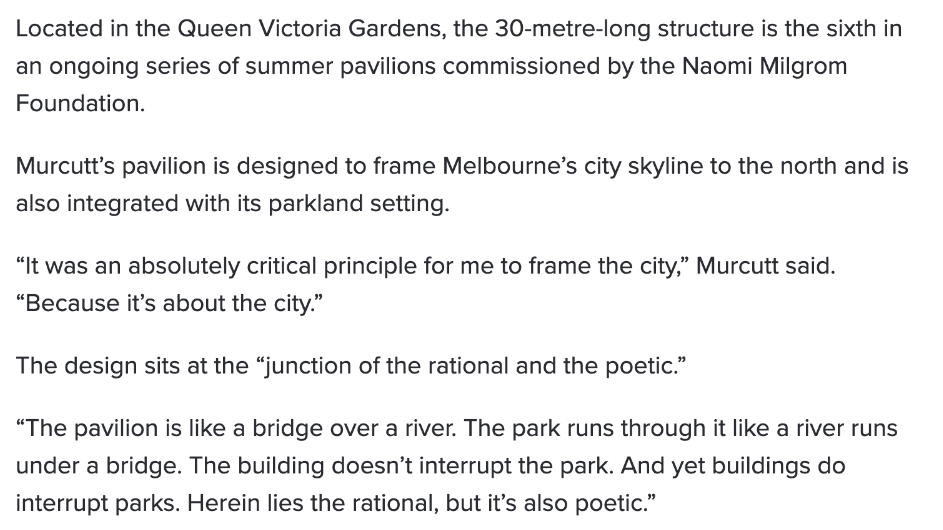
Let’s blame the architect again !!!
It is incredibly alarming to see The independent Building Reform Expert Panel’s review of Victoria’s building legislative and regulatory system. The following comments are meant to alert architects in Victoria to the issues for them implied in this document. Some architects have said this is an attack on Victorian architects; other architects see it as an opportunity for ideas of industry reform.
The panel has come up with a document that is a curious mix of ignorance regarding architects. I think the review appears to be oddly angry about us as well –– the old the architects are wankers mantra? Sure, we are not perfect, and we could always continually tweak and reform our practices. But hey, we are not responsible for the failures in the building system in Victoria. I suspect the politicians are too gutless to say who is; so why not pick on the architects. It’s a bit like that novated contract when you only did DD. You are not allowed on-site to fend off the self-serving criticisms of a contractor: Easy to blame the architect. From this perspective, in some ways, this review document looks like a policy stitch-up.

Are architects the real culprits and not the developers, contractors or project managers?
Architects battle daily with the let’s get it done cheaper, quicker and faster, without the design, from the no-design proponents. Architects are not running Phoenix company structures or producing poor quality documentation, as snidely suggested by the report. Architects are not responsible for slapdash construction methods on-site, especially after the power of their roles have been novated out of existence. Architects are always fighting against the contractors doing whatever it takes to erode design quality through the meanness of “Value Management.”
This review document arguably bears a grudge against Victorian architects. It argues that there is a “fragmented approach to the oversight of design professionals.” What does that mean exactly? It’s undoubtedly policy speak. Does it mean let’s dismantle the Victorian Architects Act and the ARBV so we can all live under the “big brother” umbrella of the Victorian Building Authority (VBA)? Will the VBA accredit our schools of architecture? Will the VBA look at logbooks and run the national Architectural Practice Exam? Will the VBA, in an effort to seek common competencies, dumb down our recently revised national competencies,
The real problem’s in the industry, as pointed out by the Cladding Taskforce, is with unregulated developers, greedy contractors and unregulated project managers. Yet if you read this report, you would think architects and the building design practitioners were responsible for all of the ills of the Victorian building system. So hey, it’s so much easier to blame and bully the architects and cloak that blame in the pursuit of regulatory reform.
Architecture is a small profession––often and easily misconstrued by larger players in the industry––and one whose industry bodies struggle to lobby government. Yet architects produce high-quality documentation and outcomes when involved in full-service procurement. Show us the statistical data that says otherwise. Show us that we are responsible for the majority of poor documentation. Yes, there are bad apples in our profession, but why see it as politically expedient to punish the entire profession. If it ain’t broke, don’t fix it.
The report has a number of serious flaws, of which the main ones are outlined below.
No practising Architects on the panel.
This is a panel with limited architectural experience. Have a look at the membership of the panel.

Architects are conflated with building designers throughout the document.
This conflation is erroneous and ambiguous as it is expressed throughout the document. It is a serious flaw in the document. Sometimes architects are identified, and yet sometimes it is not clear if they are included in the design practitioner category. It makes for total confusion, especially if you might like to submit a detailed and focused response.
The document misrepresents the context and role of the ARBV.
The report appears to imply that the ARBV only as a body of enforcement, and the implication is that the ARBV has failed to govern (or should we say punish) architects. Maybe the ARBV needs greater powers in this regard. However, the document fails to appreciate the ARBVs role in a wide range of activities: Accreditation, national competencies or registration pathways, Architectural Practice Examinations, Recognition of overseas qualifications, Alternative means of entry to registration – National Program of Assessment, Professional conduct provisions, Continuing Professional Development policies, The National Competency Standards in Architecture and the proposed national recognition of registration.

No empirical data?
Data, for example, regarding “documentation quality” is missing, and much of the document relies on numerous unsubstantiated assertions. Relying on hearsay and personal impressions is not good policy-making. This discussion framework was meant to follow on from the Victorian Cladding Taskforce, and yet few of that Taskforce’s specific recommendations are linked to what is discussed in the review.
There is also the insinuation in the document that architects know nothing about the NCC. But this area is studied in the schools and is part of the national architectural competencies. The real problem is that this report is so “REGULATION” focused that it has not approached policy reform in a holistic manner.
Policy speak?
Again, it is a report that arrogantly assumes that “umbrella” regulation and defragmenting is the way forward. But simplification and dumbing down our domain of expertise will not solve the ills of the construction industry. Let’s drag architects and the building designers under the “umbrella” as well, where we can keep an eye on them. How much will that bureaucracy cost the taxpayer?
On page 42 of the report, the registration of architects is discussed, as is the Architects Act. In the next section highlighting key issues, the report states that:
- the current registration and licensing schemes, including practitioner registration categories and classes, are limited, and not fit for purpose; and
- There are gaps in practitioner competence which are not addressed by current education and training.
How could you assert that the current accreditation arrangements for architects are not fit for purpose? It takes seven years to be an architect. Let me state that again for seven fucking years. Five years uni, two years experience and then a three-part exam. Again, the tardiness of this report is unbelievable.
Craziness for small practitioners !
Putting Building Designers and Architects together seems crazy. Govern where the information is and where people are invested in that governance. Sure we might share core competencies, sure we can all be registered by the VBA, but why lump is together in a single entity or under a new Act? The risk is that by equating professional (architects) and vocational (building designers) competencies, these two educational categories will merge. Then where will architects, and their Archi schools, be?
Such a proposal may produce unforeseen effects in labour markets, the PI insurance market and reduce competition within the market for professional services. Different categories of practitioner amongst architects may serve to consolidate large firms at the expense of small firms. As the panel may not know, small architect firms constitute 65% -75% of the industry currently.
The Archi Schools
If the report’s vague policy insinuations were implemented in detail, it might seriously disrupt the education, registration, and practice of architects in Victoria. It may have flow-on effects in other states. It would reduce the revenue of the architecture schools through confusion. At the moment, those schools have combined revenues of around $150M. There is no real revenue opportunity for the architecture schools to train up building designers. Why would they do that when their modus operandi is research. More revenue would be lost from uncoupling Victorian Archi schools from the national system than potentially gained.

Finally
The report represents a clear and present danger to the livelihood of many Victorian architects. It’s time for those architects to wake up !
This document does nothing to ensure that Victoria and Australia’s future built assets are enduring. The very problem it was hoping to solve.
It will do nothing to curb the power of phoenix developers and the culture of faster, cheaper and cheaper and cheaper. This report constrains architects from fighting for design quality in the built environment. For example, architects are the only profession with competencies related to sustainability and indigenous rights. No other professions have that to the same degree.
Let’s get architects into a big dumbed down tent of bureaucracy so we can discipline and punish them for being naughty once or twice. Really? Too bad the politicians and policy apparatchiks don’t have the spines to say who has really corroded Victoria’s building system.







































